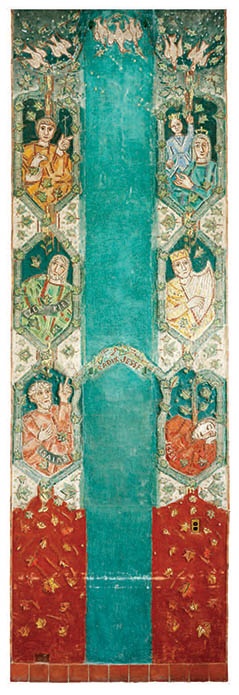
High atop the vault of STM Chapel’s east wall rises a large mosaic of the Tree of Jesse, a striking work that is both ancient and modern. It is an imposing and impactful representation of the genealogy of Christ. Its narrative starts on the right as Jesse is seen with the family tree rising from his right side. The long shaft of green at its center seems to represent a tree, although the artist has labeled it “Radix Jesse” which means in Latin “Jesse the Root” or “The Root of Jesse.” In its fullest form, the Tree of Jesse branches trace the forty-three generations between Jesse and Jesus, abbreviated here to include Ezekiel, Isaiah and David (with harp). The story culminates at the treetop with John the Baptist pointing to the crowned heads of Mary and Jesus. Across the top of the Tree we see seven doves, representing the seven gifts of the Holy Spirit, sending rays down upon the child Jesus.
The Tree of Jesse towers over the choir balcony and is often mistaken at a distance for a very large tapestry. In a way, it is a tapestry, threaded by carefully selected and placed tesserae, small individual tiles usually formed in the shape of a cube. These are often placed to reflect light onto its subject. The only reflecting tesserae here are seen in the strings of David’s harp and the crowns of Jesus and Mary.
The Scriptural provenance of this work can be found in the book of Isaiah:
“A root shall come out from the stump of Jesse,
And a branch shall grow out of his roots
The spirit of the Lord shall rest on him,
The spirit of wisdom and understanding,
The spirit of counsel and might,
The spirit of knowledge and the fear of the Lord.
His delight shall be in the fear of the Lord.”
Many images of the Tree of Jesse appeared in the early Church, often illuminating sacred texts. The large-scale images of the tree in stained glass windows in the Royal Chapel of St. Denis, Paris, and, later, in the great lancet windows of Chartres Cathedral in France, cemented their popularity in educating the churched public on the earthly origins of Christ. The use of a tree to portray this Biblical teaching also served to inspire the use of a tree as a schematic representation of a family’s genealogy. The Tree of Jesse is the only prophecy of the Old Testament to be so frequently and literally illustrated in Christian art.

The traditions of the Tree of Jesse live on in the modern form of Advent calendars, often used as a teaching aid to retell the Bible stories surrounding the birth of Jesus. Customarily, families hang an ornament daily or weekly during this season of anticipation, prompting reflection on a particularly relevant Scriptural passage about Christ.
The creator of STM's Tree of Jesse was Elsa Schmid (1897-1970), a German-American mosaicist, sculptor and painter. Schmid’s work is characterized as “Modern” and this work clearly shows her mastery of all three art forms.
Elsa Schmid was a Catholic artist considered a member of the Catholic classical liturgical movement in the United States (1926-1959). During this period, as women began to play a larger role in the liturgy and art of the Church, they drew inspiration from the words of St. Matthew’s description of the crucifixion of Christ: “There were also many women there.” Elsa Schmid’s work was exhibited widely.
Her mosaics are in the collections of the Museum of Modern Art in New York City, the Baltimore Museum and the Fogg Museum at Harvard University. Her mosaics can be found in many private collections, as well.
Schmid and her husband, J.B. Neumann (1887-1961), lived in New York City, and later, in Rye, NY. J.B. Neumann owned a noted art gallery and was a recognized art critic, author, lecturer and publisher. The couple had emigrated from Germany where J.B. had owned book stores/art galleries in Bremen, Dusseldorf and Munich. He was one of the founders of the Museum of Modern Art in New York City.
Those at STM who choose to look up and then dare to carefully ascend to the balcony will witness in person the detail of this marvelous mosaic representation of a great Christian symbol. A symbol that connects the STM community to teachings, beliefs and liturgical celebrations of past Christian communities—thus “rooting” our place in the Christian story.
This article could not have been written without the direction of John T. Paoletti, Kenan Professor of the Humanities, Emeritus, and Professor of
Art History, Emeritus, at Wesleyan University.
Works Referenced:
Elsa Schmid Papers 1910-1967. Archives of American Art: Smithsonian Institution.
Harmon, Katherine E. There Were Also Many Women There: Lay Women in the Liturgical Movement in the United States, 1926-59. Collegeville, MN: Liturgical Press, c2012.
"Obituary of Mrs. J. B. Neumann." The New York Times. January 15, 1970.
Saint Thomas More Chapel. Symbolism.